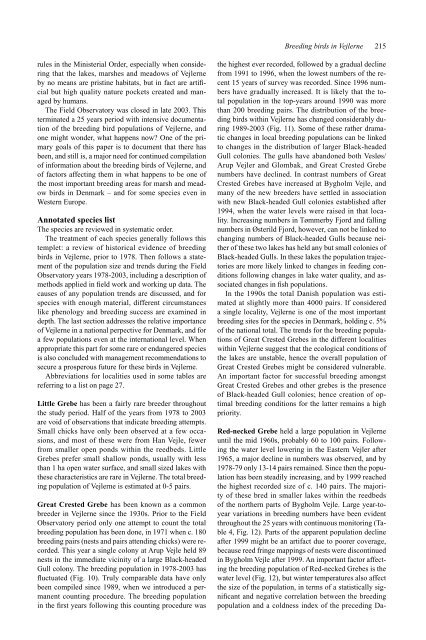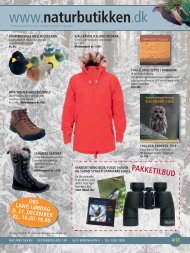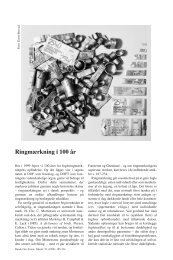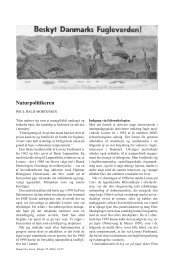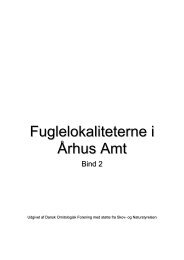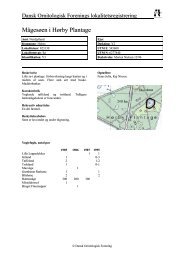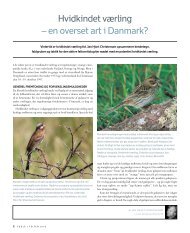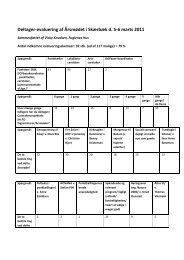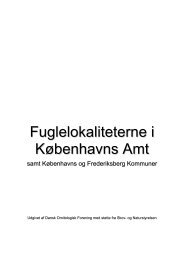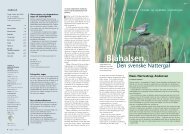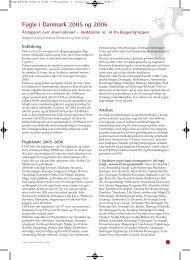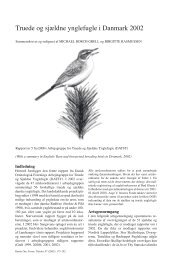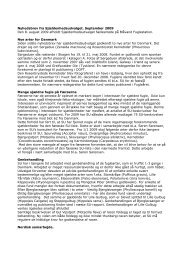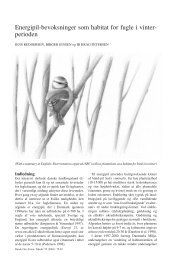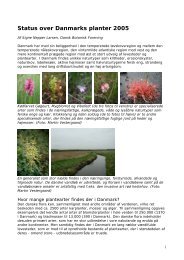Ynglefugle i Vejlerne - Dansk Ornitologisk Forening
Ynglefugle i Vejlerne - Dansk Ornitologisk Forening
Ynglefugle i Vejlerne - Dansk Ornitologisk Forening
Create successful ePaper yourself
Turn your PDF publications into a flip-book with our unique Google optimized e-Paper software.
ules in the Ministerial Order, especially when consi dering<br />
that the lakes, marshes and meadows of <strong>Vejlerne</strong><br />
by no means are pristine habitats, but in fact are articial<br />
but high quality nature pockets created and managed<br />
by humans.<br />
The Field Observatory was closed in late 2003. This<br />
terminated a 25 years period with intensive documentation<br />
of the breeding bird populations of <strong>Vejlerne</strong>, and<br />
one might wonder, what happens now? One of the primary<br />
goals of this paper is to document that there has<br />
been, and still is, a major need for continued compilation<br />
of information about the breeding birds of <strong>Vejlerne</strong>, and<br />
of factors affecting them in what happens to be one of<br />
the most important breeding areas for marsh and meadow<br />
birds in Denmark – and for some species even in<br />
Western Europe.<br />
Annotated species list<br />
The species are reviewed in systematic order.<br />
The treatment of each species generally follows this<br />
templet: a review of historical evidence of breeding<br />
birds in <strong>Vejlerne</strong>, prior to 1978. Then follows a statement<br />
of the popula tion size and trends during the Field<br />
Observatory years 1978-2003, including a description of<br />
methods applied in eld work and working up data. The<br />
causes of any population trends are discussed, and for<br />
species with enough material, different circumstances<br />
like phenology and breeding success are examined in<br />
depth. The last section addresses the relative importance<br />
of <strong>Vejlerne</strong> in a national perpective for Denmark, and for<br />
a few populations even at the international level. When<br />
appropriate this part for some rare or endangered species<br />
is also concluded with management recommendations to<br />
secure a prosperous future for these birds in <strong>Vejlerne</strong>.<br />
Abbreviations for localities used in some tables are<br />
referring to a list on page 27.<br />
Little Grebe has been a fairly rare breeder throughout<br />
the study period. Half of the years from 1978 to 2003<br />
are void of observations that indicate breeding attempts.<br />
Small chicks have only been observed at a few occasions,<br />
and most of these were from Han Vejle, fewer<br />
from smaller open ponds within the reedbeds. Little<br />
Grebes prefer small shallow ponds, usually with less<br />
than 1 ha open water surface, and small sized lakes with<br />
these characteristics are rare in <strong>Vejlerne</strong>. The total breeding<br />
population of <strong>Vejlerne</strong> is estimated at 0-5 pairs.<br />
Great Crested Grebe has been known as a common<br />
breeder in <strong>Vejlerne</strong> since the 1930s. Prior to the Field<br />
Observatory period only one attempt to count the total<br />
breeding population has been done, in 1971 when c. 180<br />
breeding pairs (nests and pairs attending chicks) were recorded.<br />
This year a single colony at Arup Vejle held 89<br />
nests in the immediate vicinity of a large Black-headed<br />
Gull colony. The breeding population in 1978-2003 has<br />
uctuated (Fig. 10). Truly comparable data have only<br />
been compiled since 1989, when we introduced a permanent<br />
counting procedure. The breeding population<br />
in the rst years following this counting procedure was<br />
Breeding birds in <strong>Vejlerne</strong> 215<br />
the highest ever recorded, followed by a gradual decline<br />
from 1991 to 1996, when the lowest numbers of the recent<br />
15 years of survey was recorded. Since 1996 numbers<br />
have gradually increased. It is likely that the total<br />
population in the top-years around 1990 was more<br />
than 200 breeding pairs. The distribution of the breeding<br />
birds within <strong>Vejlerne</strong> has changed con si de rab ly during<br />
1989-2003 (Fig. 11). Some of these rather dramatic<br />
changes in local breeding populations can be linked<br />
to changes in the distribution of larger Black-headed<br />
Gull colonies. The gulls have abandoned both Vesløs/<br />
Arup Vejler and Glombak, and Great Crested Grebe<br />
numbers have declined. In contrast numbers of Great<br />
Crested Grebes have increased at Bygholm Vejle, and<br />
many of the new breeders have settled in association<br />
with new Black-headed Gull colonies established after<br />
1994, when the water levels were raised in that locality.<br />
Increasing numbers in Tømmerby Fjord and falling<br />
numbers in Østerild Fjord, however, can not be linked to<br />
changing numbers of Black-headed Gulls because neither<br />
of these two lakes has held any but small colonies of<br />
Black-headed Gulls. In these lakes the population trajectories<br />
are more likely linked to changes in feeding conditions<br />
following changes in lake water quality, and associated<br />
changes in sh populations.<br />
In the 1990s the total Danish population was estimated<br />
at slightly more than 4000 pairs. If considered<br />
a single locality, <strong>Vejlerne</strong> is one of the most important<br />
breeding sites for the species in Denmark, holding c. 5%<br />
of the national total. The trends for the breeding populations<br />
of Great Crested Grebes in the different localities<br />
within <strong>Vejlerne</strong> suggest that the ecological conditions of<br />
the lakes are unstable, hence the overall population of<br />
Great Crested Grebes might be considered vulnerable.<br />
An important factor for successful breeding amongst<br />
Great Crested Grebes and other grebes is the presence<br />
of Black-headed Gull colonies; hence creation of optimal<br />
breeding conditions for the latter remains a high<br />
priority.<br />
Red-necked Grebe held a large population in <strong>Vejlerne</strong><br />
until the mid 1960s, probably 60 to 100 pairs. Following<br />
the water level lowering in the Eastern Vejler after<br />
1965, a major decline in numbers was observed, and by<br />
1978-79 only 13-14 pairs remained. Since then the population<br />
has been steadily increasing, and by 1999 reached<br />
the highest recorded size of c. 140 pairs. The majority<br />
of these bred in smaller lakes within the reedbeds<br />
of the northern parts of Bygholm Vejle. Large year-toyear<br />
variations in breeding numbers have been evident<br />
throughout the 25 years with continuous monitoring (Table<br />
4, Fig. 12). Parts of the apparent population decline<br />
after 1999 might be an artifact due to poorer coverage,<br />
because reed fringe mappings of nests were discontinued<br />
in Bygholm Vejle after 1999. An important factor affecting<br />
the breeding population of Red-necked Grebes is the<br />
water level (Fig. 12), but winter temperatures also affect<br />
the size of the population, in terms of a statistically signicant<br />
and negative correlation between the breeding<br />
population and a coldness index of the preceding Da


